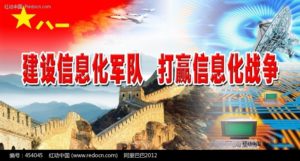Chinese Military Review: From Army Information Construction to Construction of Information Army //
中國軍事評論:從軍隊信息建設到建設信息化軍隊
2006年04月20日 22:00
From the Army Information Construction to the Construction of Informatized Army——Opening the Eyes to See the New Military Revolution in the World
Li Bingyan
A few years ago, there was a curtain factory abroad that was on the verge of bankruptcy and turned to the consulting company. The consulting company only asked them to change the curtain factory to a shading technology factory, and the factory would survive.
A name change has broadened the horizon of development; a concept change has opened up the mind shackles. Updating the concept is inseparable from the concept of renewal. In the new military revolution, we need to adopt new concepts in a timely manner to show new development ideas.
Although the ongoing new military revolution still does not see the other side, it is clear that the change has entered a new stage.
This new military revolution was triggered by a new technological revolution centered on information technology. In the 1990s, the revolutionary impact of information technology on the military mainly remained at the stage of “construction”, that is, information technology embedding, networking, networking, and integration within the framework of the mechanized military organization. Technology strengthens mechanization and enhances mechanization. The theoretical community often refers to this stage of change as a revolution in the military field, which is to promote the army.
Information construction. At that time, the digital division and the digital army to be built by the US Army were carried out within the structure of the original mechanized army. Later, the US military learned from the experience of informatization of some large enterprises and multinational corporations in the society and changed the way of thinking.
In the past, military changes were first to change military technology, weapons and equipment, and finally to complete the transformation of the military organizational system to adapt to the new methods of warfare. The new military revolution, characterized by informatization, especially the post-launch army, should be reversed. The experience of the business community is also “first rationalization of organizational structure, re-automation, informationization.”
Before the 1990s, the US business community carried out informatization construction, focusing only on improving work efficiency. Although effective, it still cannot be changed. Ford Motor Company has spent a lot of money on automation, and its office efficiency has improved significantly. For example, the financial department of the North American branch has reduced the number of employees from 500 to 400 after office automation. The company leaders think it is good. Later, they learned about Japan.
Mazda Motor Company did the same job and used only five people. In contrast, Ford’s leadership was shocked. After in-depth investigation, they found that Mazda started to adjust the organizational structure, first change the workflow, and then engage in office automation. Ford’s financial system, organizational structure or traditional model has caused a lot of useless work. Later, Ford Company optimized its structure, re-engineered its business processes, and started office automation on this basis. The company’s financial staff was compressed to a quarter.
In the development of human society, there is a phenomenon of “path dependence”. After a social system is formed, it will continue to strengthen itself in the actual operation, so that people will not be able to get rid of the influence of the original ideas afterwards.
In addition, the organizational structure does not change, it is difficult to make the right decision in information. Usually, people are standing in their own units and planning work in this department, forming a “professional syndrome.” The research informatization is first of all the informationization of the unit, beyond the scope of construction of the unit, the leadership vision will not be achieved. This has led to the emergence of new “isomorphic diseases” – large and complete, small and complete, you have me, can not be interconnected, interoperable, interoperable. In this regard, some people call it the “potato effect”: a sack of potatoes, all sprouting, each self-contained system, self-enclosed, and not connected. Building these systems may be reasonable from a local perspective, but it may not be scientific or irrational from the overall perspective of informatization.
In the practice, the foreign military realized that if informationization is not detoured, it should start with rationalizing the system and adjusting the command system. Otherwise, all levels and departments are busy with informationization. It is likely that the faster and the more the action is now, the greater the losses will be caused once reworked in the future.
The rationalization of the organizational structure, the consideration of informationization, or the rationalization of organizational structure and informationization, and the simultaneous development have become a new consensus on the new military revolution. After entering the 21st century, the US military proposed a military transformation, marking a new stage in military transformation. At this stage, information technology has shifted from a “construction” role to a “deconstruction” role. That is: instead of strengthening mechanization, it is reorganizing mechanization. As a result, the army’s informatization construction has turned to the construction of an information-based army; the changes in the military field have turned to real military changes.
In the theoretical preparation stage of the US military, the future army that was designed was: the sensor army, the precision strike army, the dominant mobile army, and the logistics army. In the transition, after a new argument, the future goals of the US military reorganization are proposed: the full-dimensional battlefield perception army, the precision firepower strike army, the efficient command and control army, and the intelligent logistics support army.
In 2005, Germany proposed the idea of building a “new three armed forces”, namely: rapid reaction forces, standing combat troops, and logistics support forces.
At the end of last year, the Russian General Staff Department completed the reform of the armed forces. The Russian military’s new round of structural reforms eliminated the arms, military regions and fleets and re-established three functional headquarters and three regional headquarters. The three functional commands are: Strategic Nuclear Power Command, Transportation Command, and Aerospace Defense Command. The three regional commands are: Western European Command, Central Asian Command and Far East Command.
Generally speaking, although the structural changes of the military have their own characteristics, the common point is that they tend to be integrated and tend to be integrated, and the boundaries between the traditional arms and services are increasingly blurred. The informationized army is not just a technology, but a new structure that is linked to new technologies – ultimately, a structural decision function.
Original Mandarin Chinese:
從軍隊信息建設到建設信息化軍隊——放開眼界看世界新軍事變革
李炳彥
幾年前,國外有一家窗簾廠,瀕臨倒閉之際,求助於諮詢公司。諮詢公司只讓他們把窗簾廠改為遮光技術廠,這個廠子便活了起來。
一個名字改變,拓寬了發展視野;一個概念更換,撬開了心智枷鎖。更新觀念,離不開更新概念。在新軍事變革中,我們需要適時採用新的概念,來展現新的發展思路。
持續發生的新軍事變革雖然至今仍看不到彼岸,但清晰可見變革已經進入到一個新階段。
這場新軍事變革,是由以信息技術為核心的新技術革命引發的。上個世紀90年代,信息技術對軍隊的革命性影響,主要還停留於“建構”階段,即在機械化軍隊的組織結構框架內進行信息技術嵌入、建網、聯網、集成,實際上是用信息技術加強機械化、提昇機械化。理論界常把這一階段的變革,稱之為軍事領域裡的變革,是推動軍隊
信息化建設。當時,美陸軍要建設的數字化師、數字化軍,都是在原來機械化軍隊的結構內進行的。後來,美軍汲取社會上一些大企業、跨國公司進行信息化的經驗,改變了變革的思路。
以往的軍事變革,都是先變革軍事技術、武器裝備,最後完成軍事組織體制的變革,以適應新的作戰方式。而信息化為標誌的新軍事變革,特別是後發之軍,應當反過來進行。企業界的經驗也是“先組織結構合理化,再自動化、信息化”。
上個世紀90年代以前,美國企業界進行信息化建設,只著眼於提高工作效率,雖有成效,但還談不上變革。美福特汽車公司,曾花大筆金錢搞自動化,辦公效率明顯提高,如北美分公司的財務部,實現辦公自動化後,人員由原來的500人減少到400人,公司領導自認為不錯。後來,他們得知日本
馬自達汽車公司做同樣的工作,一共只用了5個人。兩者相對照,福特公司的領導大吃一驚。他們深入調查後發現,馬自達公司從調整組織結構入手,先改變工作流程,再搞辦公自動化。福特公司的財務制度、組織結構還是傳統模式,造成許多無用功。後來,福特公司經過優化結構,再造業務流程,在此基礎上搞辦公自動化,公司財務員工壓縮到了原來的四分之一。
人類社會在發展中,存在一種“路徑依賴”現象,即一個社會系統形成後,必將在實際運作中不斷自我強化,以致後來人們改進它的種種嘗試,都難以擺脫原有思路的影響。
另外,組織結構不改變,很難做出信息化的正確決策。通常,人們都是站在本單位、本部門謀劃工作,形成了一種“職業官能症”。研究信息化首先是本單位的信息化,超出本單位的建設範圍,領導視野就達不到了。致使出現新的“同構病”——大而全、小而全,你有我也有,不能互聯、互通、互操作。對此,有人稱之為“馬鈴薯效應”:一麻袋馬鈴薯,個個都發芽,個個自成小系統,自我封閉,互不相聯。建這些系統,從局部來看可能合理,但從信息化的全局看可能並不科學、不合理。
外軍在實踐中認識到:要想信息化不走彎路,還應從理順編制體制、調整指揮體系入手。否則,各級、各部門都忙著信息化,很可能現在動作愈快、投入愈多,將來一旦返工,造成的損失就愈大。
先組織結構合理化,在信息化,或者組織結構合理化與信息化一併考慮,同時進行,成了新軍事變革的一種新共識。進入21世紀後,美軍提出軍隊轉型,標誌著軍事變革進入了一個新階段。在這個階段,信息技術從“建構”作用,轉向“解構”作用。即:不是加強機械化,而是重組機械化。由此,軍隊信息化建設,轉向了建設信息化軍隊;軍事領域裡的變革,轉向真正的軍事變革。
美軍在理論準備階段,曾設計出的未來軍隊是:傳感器軍,精確打擊軍,主導機動軍,聚焦後勤軍。在轉型中,經過新的論證,提出美軍重組的未來目標:全維戰場感知軍,精確火力打擊軍,高效指揮控制軍,智能後勤保障軍。
德國於2005年,提出了建設“新三軍”設想,即:快速反應部隊,常備作戰部隊,後勤支援部隊。
去年底,俄軍總參謀部完成了關於武裝力量改革方案。俄軍新一輪結構改革方案,取消了軍兵種、軍區和艦隊,重新成立三個職能司令部和三個地區司令部。三個職能司令部是:戰略核力量司令部、運輸司令部、空天防禦司令部。三個地區司令部是:西歐司令部、中亞司令部和遠東司令部。
從總體上看,軍隊結構變革雖然各國都有自己的特色,但共同點是趨於綜合、趨於一體化,傳統的軍兵種之間的界限日益模糊。信息化軍隊不只是技術,重要的是與新技術相聯繫的新的結構方式——最終還是結構決定功能。
Original Referring url: http://mil.news.sina.com.cn/2006-04-20/

